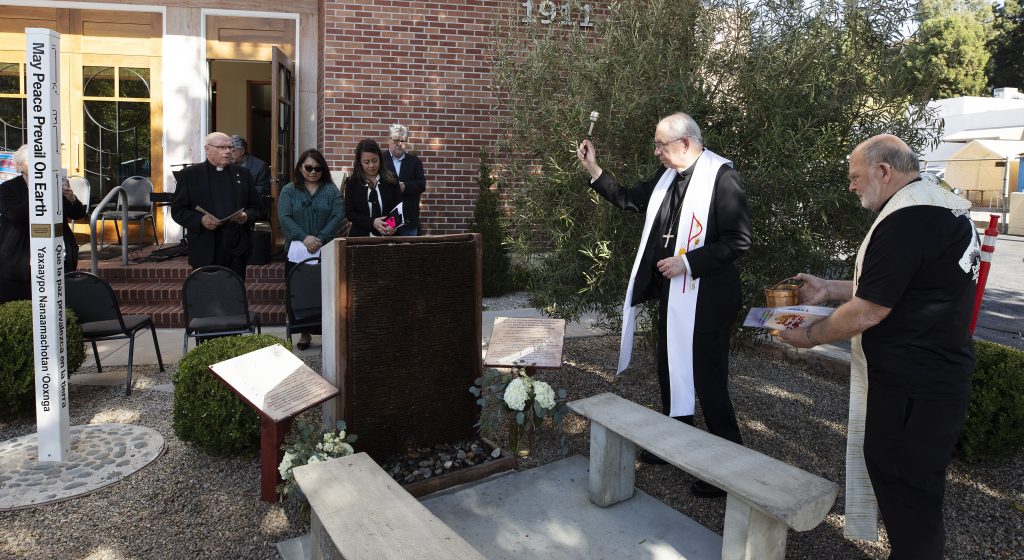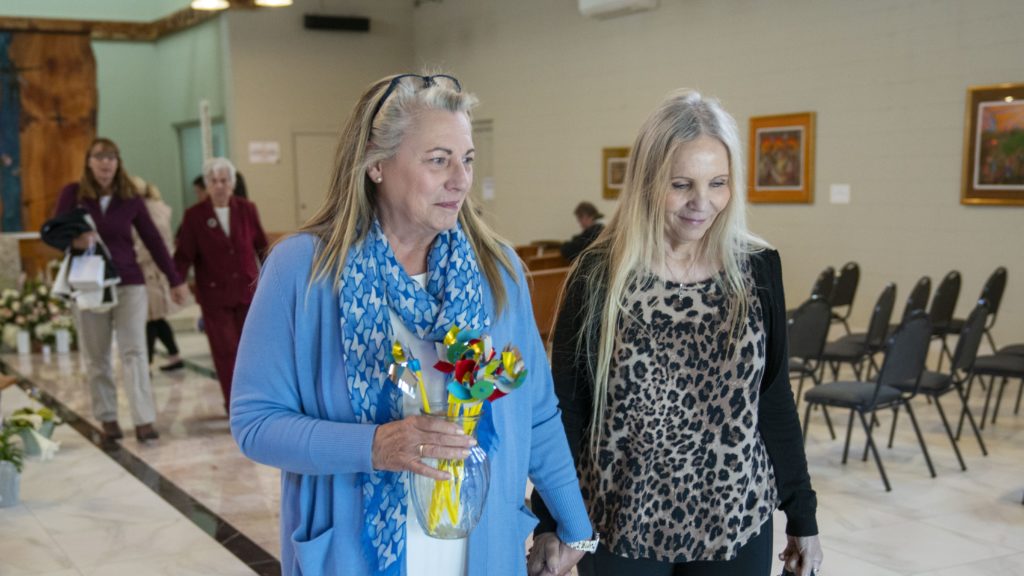All it took was one day, one act of abuse by a priest to send Deborah McAlpine’s life spiraling.
She was in high school when she was molested by a visiting priest after a Saturday night charismatic Mass at a parish in Norwalk in the early 1970s.
The abuse haunted McAlpine for years. She quickly lost interest in school. She ran away from home, only returning when her mother gave assurances she wouldn’t be forced to attend church. She sought relief from the pain in drugs and alcohol. She went more than 20 years without going to Mass.
“It pretty much destroyed my life for a long time,” McAlpine told Angelus.
When someone suggested looking for ways to come to terms with the abuse, she reached out to the Archdiocese of Los Angeles for help identifying the priest.
Even after a thorough investigation into her story, McAlpine was never able to discover the priest’s identity. (It is likely, she found, that he was a foreign priest who soon returned to his home country.) What she did find, though, were people who listened to her, believed her, and wanted to help her heal — despite the fuzzy memories after years spent trying to bury her secret.
To her surprise, she found those people in the very same institution that had betrayed her trust all those years ago: the Catholic Church.
Stories of the suffering endured by survivor-victims like McAlpine are back in the news following recent news of compensation settlements for abuse survivors, particularly the $880 million agreement to settle historical claims of abuse announced by the Archdiocese of Los Angeles last month.
Certainly, not all who have been abused by priests and other representatives of the Catholic Church have found the same path to healing as McAlpine. But the fact that she did is a telling indicator of how much the Church — particularly in places like Los Angeles — has changed.
“It’s not my shame anymore,” said McAlpine. “I’m glad I didn’t let this priest keep me away from my faith.”
Stories like McAlpine’s are the fruit of years of long, patient work on the part of the archdiocese’s Victims Assistance Ministry. Heather Banis, the office’s coordinator, is often the first voice that survivor-victims of abuse hear when they reach out to the archdiocese to report a claim or look for information. She describes her role as one of providing “radical accompaniment.”
For McAlpine, that meant spending hours with Banis poring over historical records, including decades-old photo directories of priests, to try to identify her abuser. There were regular check-in calls from Banis, and a personal “apology visit” with Archbishop José H. Gomez. Later, a compensation package from the archdiocese included regular therapy visits.
“It’s about feeling the Church’s presence, about our willingness to do all we can to assist,” said Banis. “I think that matters as much, in some cases even more than the actual outcome. Because we do believe Debbie, we believe what she said happened.”
Words like those from a representative of the Catholic Church would have been unthinkable a few decades ago, victims say.

Mary G. was 12 years old when she was abused by a priest chaplain assigned to the pediatric department of an LA-area hospital where she was staying. The suffering was made worse, Mary says, by the fact that even family members — including her own mother — were aware of the abuse but made excuses for it.
“It was as if I didn't matter at all. Many people knew I was being molested by this priest, but I was just supposed to accept it,” said Mary. “He was a priest, he was going to heaven.”
After her mother died, she wrote letters to the priest whose name she couldn’t remember.
“I wanted to know the name of the priest because I thought maybe I could find him, maybe I could ask him: Why did you do it? What were you thinking?”
One day, her adult son suggested she contact the archdiocese. “He said, ‘Mom, all you have to do is explain things to them and they can get you his name.’ ”
After reaching out, officials investigated Mary’s story and found it added up. They were able to identify the priest, who had since died. But that was only the start of a delicate, sometimes painful process.
“We helped [Mary] with that really important piece of putting a name to this person, and not only listening but corroborating what she was reporting,” said Banis. “All those things that feel impossible and unreal and in the dark, it brings it all into the light. And then you can look at it differently, and say: ‘OK, now that we know this, what do you need? Counseling? Let’s get that going. Spiritual direction? Let’s get that going. And if you’re seeking a pastoral settlement, let’s get that going.”
The process brought Mary peace, healing, and even the willingness to forgive.
“I pray for this priest, I pray for him every night,” said Mary. “I pray for him because I want to be forgiven of anything I’ve done. I haven’t molested children, but heck, I hope to gosh I’ll make it to heaven. There has to be hope out there.”
Mary is frank about the consequences of the abuse, how it affected her sense of self-worth and her ability to make decisions.
“I have become a better person later in life since this happened,” said Mary. “But it’s still what happened and I’m able to face it and speak of it without shame, without somebody saying. ‘Don’t talk about that, don’t mention it!’ ”
During the healing process, Mary said a key step was understanding that the abuse was the priest’s fault, not hers.
“Now, is it the Church's fault for covering up and letting him go on, putting him in the way of children? Yes, that’s true,” said Mary. “That is wrong. But the Church is growing, and the Church is not that way anymore.”
Likewise, McAlpine said she has a “good feeling” about the Church’s direction on abuse prevention and accountability, especially under Pope Francis. Last April, she attended a Mass marking Abuse Prevention Month at the St. Camillus Center for Spiritual Care near East LA, home of one of several “healing gardens” in the LA Archdiocese designed with the help of survivor-victim Joe Montanez as a place of prayer and meditation for those hurt by abuse. She admits the idea made her angry at first.
“They're spending all this money on the healing garden to make their church look nice and pretty. But what about the people?” McAlpine remembered thinking.
But during her first visit, McAlpine found herself reading the plaques in the garden and praying a rosary on one of the benches. Her opinion changed.
“It felt very personal. I felt like this is my place, this is for me.”
McAlpine believes the gardens can be a “first step” for victims who may not feel ready to “come back” to church after what they’ve suffered.
“At least they have a place that they can go to,” she said. “If they allow themselves to forgive, because forgiving is for us, not just for the person who did it.”
Meanwhile, Banis’ office reports a slight but limited uptick in calls since the Oct. 16 settlement announcement — nothing like the days of the clerical abuse crisis’ first wave two decades ago. Banis attributes the rather muted reaction to a “change of culture” in Los Angeles.
“I think it’s because people in the pews have a deeper understanding of the impact of clergy sexual abuse,” said Banis. “They’ve seen how the Church continues to take accountability.”
“The numbers [of the settlement agreement] are staggering, and they may not like it,” continued Banis. “But I attribute it to our Church understanding much better what needs to happen than we did 20 years ago.”

